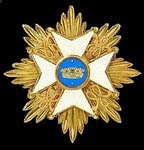Chefs: First raised 1741 by Major General Gerhard Cornelius von Walrave (who was sentenced to life imprisonment in 1748 for fraud and treason, and died in prison in 1773 at Neisse in a fortress he had himself designed); he was chef from the 8th January 1742; from 27th February 1748 Colonel Philipp Loth von Sers; from 26th November 1758 to 1770 Major General Christian Friedrich von Diericke, later Lieutenant General
The flags may not be the most attractive Prussian flags but the regiment is interesting. Beginning as Walrave's Pioneer Regiment, first raised in 1741 and based at Neisse and responsible for making and repairing military roads, the regiment shared in Walrave's disgrace: "Walrave's disgrace signified more than the end of an individual career. His Pioneer Regiment was converted into an ordinary regiment of infantry in the Seven Years War, and the Prussian Engineering Corps, which he had done so much to set up, was as good as broken with him. Thereafter Frederick flattered, exploited and finally cast away a series of engineers in the same manner in which the less industrious monarchs of the time used to work through a string of mistresses". Duffy, Army of Frederick the Great, 2nd Edition. The ten musketeer companies of the regiment were converted into an infantry regiment of fusiliers on 26th November 1758, although the two companies of miners remained as a separate entity.
Even before conversion to an ordinary infantry regiment, the unit had been used in various ways. After the defeat at Kolin in 1757 its First Battalion was sent to defend the important magazine at Zittau. On July 23rd 150 men of the unit were captured in the burning city with their commander, Colonel von Diericke.
In 1758 it joined the King's Army and was used in the siege and capture of Schweidnitz in April and then at the unsuccessful siege of Olmütz. On August 25th at Zorndorf it performed heroically and attacked two enemy batteries, capturing two howitzers and six powder wagons. (Duffy, Army of Frederick the Great, 1st Edition (henceforth AFG1) shows at least 35% casualties in both battalions.) It was then with the Pomeranian Corps under Dohna, observing the Russians while the King moved away. On November 26th it officially became a fusilier regiment and Major General von Diericke became its chef. It was at Kay with Wedell on July 23rd, attacking the Palzig Heights and being beaten back with heavy casualties. Joining the King and Finck in August, it went to Kunersdorf on September 11th. During the battle it protected the artillery and fought hard until the enemy took the guns. Surrounded at the end, most of the regiment was captured. (AFG1 oddly shows only 30-35% casualties.) Those who escaped joined Manteuffel in his bid to push the Swedes back across the Peene in November.
It was with Prince Heinrich holding position on the Triebisch at the end of April 1760. With the King's forces in Saxony in October, it attacked the Süptitz Heights at Torgau on November 3rd and took hundreds of prisoners.
In 1761 it served with Prince Heinrich in a number of minor actions in Saxony, and in 1762 manned the Pretzschendorf fort there and the area between Wilder Weisseritz and the Elbe.
After the war in 1763 the King praised it but then in 1764 he said it "did not amount to much"! Frederick liked to be capricious and make sure that no-one could take his approval for granted.
And this was the uniform in 1758, with the unusual orangey-red smallclothes:



















